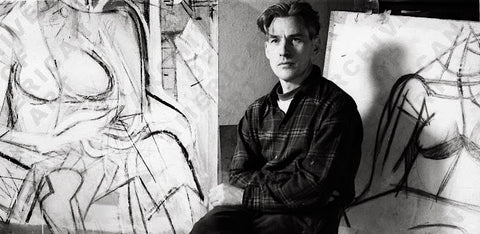KOONING, WILLEM DE

Willem de Kooning (April 24, 1904 Rotterdam, The Netherlands – March 19, 1997 Long Iceland, New York) was one of the most important representatives of Abstract Expressionism and he counts next to Jackson Pollock as a pioneer of the action painting.
His style moves on the line between abstraction and representation, in periods of expressionism, cubism, and surrealism.
In 1916 de Kooning studied with graphic artist Jaap Gidding, who gave him a position as interior decorator in 1920. Influenced by the newly created paintings by the newly founded De Stijl group, he began by the end of 1924 to take evening classes at the Rotterdamer Academie voor Beldende Kunsten en Technische Wetenschappen (today’s Willem de Kooning Academie).
He was fascinated by the rapidly growing “New World”, which seemed to him full of possibilities. After two unsuccessful attempts, he illegally embarked on the British ship “SS Shelley” in the USA on July 18, 1926 from Belgium. De Kooning was hiding during the crossing in the engine room of the ship.
At first he settled in New Jersey, where he did occasional work as a painter and carpenter.
In 1927, de Kooning moved to New York, where he worked for the next eight years as a utility photographer, interior decorator, sign painter for shop inscriptions, and as a facade painter for nightclubs.
In 1934 de Kooning was commissioned to carry out a part of the wall painting Medicine for the Hall of Pharmacy of the World Exposition in New York in 1939, which attracted art critics for the first time to the new artist whose images are so completely disrupted Familiar, factual character of the outgoing American realism.
In 1942 Willem de Kooning met Jackson Pollock at New York’s The Club on 39th Street.
Apart from de Kooning, the club included Elaine and painter friends like Arshile Gorky, Stuart Davis, Barnett Newman, Mark Rothko and Clyfford Still.
In the same year, the group exhibition American and French Paintings in the Mc Millen Gallery was shown, in which, alongside de Kooning and Pollock, Stuart Davis and Lee Krasner, Europeans Georges Braque, Pablo Picasso and Henri Matisse were shown in comparison.
With Jackson Pollock de Kooning joined a friendship, which ended in rivalry at the end of the 1940s.
But despite all the artistic competition, de Kooning and Pollock were still inspired by each other.

